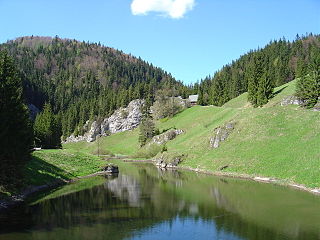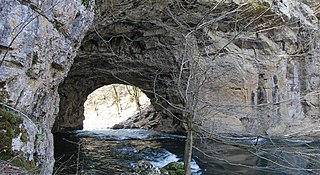
The Pont d'Arc is a large natural bridge, located in the Ardèche département in the south of France, 5 km from the town of Vallon-Pont-d'Arc.

Optymistychna is a gypsum cave located near the Ukrainian village of Korolivka, Borshchiv Raion, Ternopil Oblast. Approximately 230 km (140 mi) of passageways have been mapped within. As a result, it is the longest cave in Eurasia and the fifth-longest cave in the world, after Mammoth Cave, Sistema Sac Actun, Jewel Cave and Sistema Ox Bel Ha. It is also the longest gypsum cave in the world.

Slovak Paradise is a mountain range in eastern Slovakia. It is a part of the Spiš-Gemer Karst, which in turn is a part of the Slovak Ore Mountains, a major subdivision of the Western Carpathians. It is located between the towns of Spišská Nová Ves in the north and Dobšiná in the south. It is particularly known for its gorges and waterfalls. It is very popular with hikers as it has a number of unusual routes through gorges and waterfalls. There are numerous sections where fixed ladders are used to climb. The area is protected by Slovak Paradise National Park.

Ledenika is a cave in the Northwestern parts of the Balkan Mountains, 16 km away from the Bulgarian city of Vratsa. Its entrance is approximately 830 m above sea level. The cave features an abundance of galleries and impressive karst formations including stalactites and stalagmites. It was first discovered around the beginning of the 20th century and has been open to tourists since 1961. Ledenika Peak on Graham Land in Antarctica is named after the cave, in recognition of its cultural importance.

Scărișoara Cave, is one of the biggest ice caves in the Apuseni Mountains of Romania, in a part of Carpathian chain. It is considered a show cave and one of the natural wonders of Romania. It has also been described as a glacier cave.

The Hölloch is a 200.4 km (124.5 mi) long cave in the municipality Muotathal in Switzerland. In addition to being the second longest cave in Europe, it is also notable for having a depth of 938.6 m (3,079 ft). The Hölloch is an example of a karst cave system.

Rak Škocjan is a valley and a landscape park, part of Inner Carniola Regional Park in southwestern Slovenia. Administratively, it belongs to the settlement of Rakov Škocjan. Rak Škocjan has been protected since 1949 and is the oldest landscape park in Slovenia.
The Topolnița is a left tributary of the river Danube in Romania. In the central Mehedinți Plateau it descends into Topolnița Cave, eventually emerging at the foot of a hill downstream. It discharges into the Danube in Drobeta-Turnu Severin. Its length is 44 km (27 mi) and its basin size is 360 km2 (140 sq mi).
Porow Cave is a limestone cave in the Zagros Mountains, north of Kermanshah in Western Iran. At 751 m deep, it is the deepest cave in Iran. Joujar Cave has been reported as the second deepest, at 568 m deep.
Kef Toghobeit is a karst cave near the settlement of Bab Taza in Chefchaouen Province, Tanger-Tetouan-Al Hoceima, in northern Morocco. Currently known to be 4,078 m (13,379 ft) long and 722 m (2,369 ft) deep, it is the deepest cave in Morocco, and the third deepest cave in Africa. Although Kef Toghobeit has been well-explored, its full extent is not yet known. Only 1000 caves are known in Morocco, many of them barely mapped, although the geology would suggest that many more do exist.

Coliboaia Cave is located in Apuseni Natural Park, Câmpani, Bihor County, Romania. It contains the oldest known cave paintings of Central Europe, radiocarbon dated to 32,000 and 35,000 years BP, corresponding to the Aurignacian and Gravettian cultures of the Paleolithic period.

The Cascades de Karfiguéla or the Banfora Cascades are a series of waterfalls along the Komoé River in Southwestern Burkina Faso. They are located about 12 km northwest of Banfora and constitute one of the most important tourism sites in Burkina Faso. The Cascades Region gets its name from the waterfalls. The flow of the falls peaks during the rainy season from June to September.

Cuciulat Cave is located on the Podișul Someșan plateau, near the village Cuciulat in the commune Letca, Sălaj County, Romania. It contains the oldest known cave paintings in Central Europe.
Anou Boussouil is a limestone karst cave located in the mountains of Djurdjura, Algeria. The cave is 3,200 metres (10,500 ft) long and 805 metres (2,641 ft) deep. The entrance to the cave is 1,074 metres (3,524 ft) up the mountainside. During the springtime rainy season, melting snow pours through a channel leading directly to the cave mouth, continuing the process of erosion. This distinguishes it from other caves in the Djurdjura range, which are inactive and no longer being enlarged through erosion.
Ain ez Zarqa is a natural artesian karst spring located south of Hermel in the Beqaa Governorate, Lebanon. Producing an average of 3,435 gallons per second, it is the main source of the Orontes River. Because of its heavy flow, it is characterized as a first-magnitude spring. It sits beneath the caves at Deir Mar Maroun, an ancient monastery carved into the cliffs that surround the spring. Melting snow from these nearby heights supplements the spring's large groundwater reservoir, in the Jurassic and Cretaceous strata. It is estimated that the spring's phreatic zone reservoir contains as much as 10 billion cubic metres of storage. As a result, its flow has been less affected by overpumping and drought than other springs in the Orontes river basin.

Topolnița Cave is a karst cave located in Mehedinți County, Romania. It is the fourth-longest cave in Romania: only Peștera Vântului, Humpleu-Poienița Cave, and Hodobana Cave are longer. Most speleological sources estimate its length at 20.5 km (12.7 mi), although a length of 22 km (14 mi) has also been reported. Some Romanian news sources report a more conservative 11,000 metres (36,000 ft). It is considered a natural monument of Romania.












